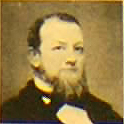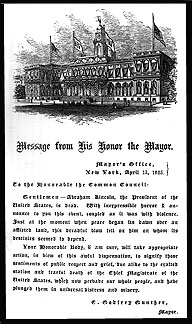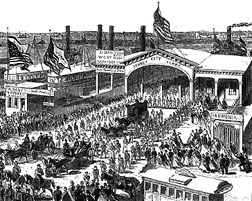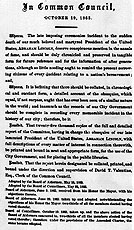Lincoln's funeral train left Washington April 21, 1865 essentially to retrace the 1,654 mile route he had traveled to Washington as President-elect for the inaugural in February, 1861. The Lincoln Special had a large photograph of him over the cowcatcher.
After a six-hour trip from Philadelphia, the martyred President's final journey home to Springfield, Illinois, brought the train on Monday, April 24, to Jersey City's huge railway station at 10 a.m. But the big clock inside had been deliberately frozen to read 7:20, the time of Mr. Lincoln's death April 15 in the District of Columbia.
His coffin was removed from the railroad car and taken across the Hudson River by ferry. Also aboard was a delegation of New York officials, including Mayor Gunther who nine days earlier had officially communicated news of Lincoln's death to the Common Council with a formal message that declared:
The funeral ferry Jersey City slowly crossed the North River (aka Hudson River). Guns boomed. Bells tolled. Flags flew at half-mast. Ships and boats in New York Harbor displayed black mourning crape and muslin.
After the ferry docked at its Manhattan terminal near the foot of Desbrosses Street, the coffin was placed in a glass hearse topped by eight large plumes of black and white feathers and drawn by six gray horses. A procession of military and civilians, led by Gen. Dix, escorted it to City Hall. The route: Desbrosses St. crossing Greenwich and Hudson Streets to Canal St. (in the vicinity of what is now the entrance to the Holland Tunnel), Canal to Broadway, then down Broadway to City Hall Park.
At City Hall the coffin was carried up the circular staircase under the rotunda. It was then placed in a black velvet dais. The public was admitted after 1 p.m. Upwards of 500,000 people waited in line to view the body. The next day, Tuesday, April 25, at about 2 p.m., Lincoln's coffin was placed on a magnificent 14-foot long funeral car drawn by 16 horses. A funeral procession went up Broadway to 14th Street, over to 5th Avenue, up 5th to 34th Street, and across 34th to 9th Avenue to the Hudson River Railway Depot.
It is interesting to note that among the various public officials listed in the published order of march were the Commissioners of Charities and Correction as part of the County Government contingent. Tens of thousands of ordinary citizens also marched in the huge procession while hundreds of thousands more lined the streets and watched from nearby windows where standing space was rented up to $100 per person. Shortly after 4 p.m. the funeral train departed for Albany 141 miles away. Large crowds gathered as the train passed through -- slowly but not stopping -- the various towns along the route, including Sing-Sing.
By any measure, the massive and moving observances in New York City mourning the slain President were momentous, a fact recognized by many participants at the time. For the stated purposes of preserving an official record of that historic moment and of promoting its appreciation among later generations, the Common Council authorized -- Aldermen voting on May 15 and Councilmen on May 22 -- publication of the full report of the committee in charge of those arrangements (obsequies).
But Mayor Gunther vetoed the publication. His objections to it were received by the Board of Aldermen on June 3. Little more than three weeks later the Aldermen overrode the veto by satisfying the two-thirds majority requirement. However, the City Councilmen waited more than three months before overriding the mayoral veto. On Oct. 19 -- with the mayoral election only a couple of weeks away -- the Council overrode the veto, also satisfying the two-thirds majority requirement.
Whereas, in his message to the Common Council announcing the assassination, Gunther had spoken almost impersonally about expressing "sentiments of public respect and grief, due alike to the exalted station and fearful death of the Chief Magistrate," the Common Council in its resolution authorizing the obsequies publication spoke of "our much beloved and martyred President." One suspects Lincoln was not "much beloved" by Gunther. His opposition to Lincoln's war policies, especially the Emancipation Proclamation, was quite evident in the mayor's Sept. 29, 1864 message [cited in Chapter 3] vetoing the Council resolution for a "public illumination" to celebrate recent victories of Union forces. His "unofficial and private" letter to Lincoln concerning blankets for the Elmira POWs [cited in Chapter 3] can be given a reading as expressing thinly veiled contempt for the President. Despite the letter's protestations to the contrary, the mayor's message obviously was appealing to Lincoln to do something that Gunther thought ought to be done without his or anyone having to make such an appeal for it to be done. It ought be, wrote Gunther, "the spontaneous act of the Executive on his own motion and from the promptings of his own benevolence." Obviously Gunther did not think Lincoln would engage in such "spontaneous benevolence," thus the "unofficial" letter constitutes necessary outside "prompting." In addition to Gunther's political differences with -- and quite possibly personal disdain for -- Lincoln, the mayor also likely viewed the Common Council's publishing the obsequies as a political ploy. Given that Gunther was the Peace Democrat running for re-election as mayor, the publication's effusions over the slain War President could be seen as promoting the mayoral candidacy of "War Democrat" John T. Hoffman. William Magear "Boss" Tweed's nominee, Tammany Haller Hoffman had made a name for himself presiding over the legal proceedings against the 1863 draft rioters. Tweed and other War Democrats were prominent members of the committee in charge of the obsequies. Therefore, the mayor had every reason to anticipate that they would exercise influence shaping the publication's content and themes in ways not supportive of his position. Furthermore, the expense in publishing an official record of the funeral ceremonies also may have offended Gunther's well-known frugality, since newspapers had already printed extensive and detailed reports of the events. Whatever the mayor's motives for his veto and Council's motives for overriding it, researchers today can only be glad the publication resolution prevailed. Had it not, we would not have such a compact, detailed and beautifully illustrated official record to study and admire. |









